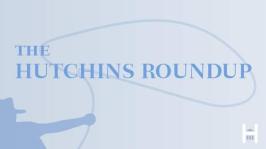
What’s the latest thinking in fiscal and monetary policy? The Hutchins Roundup keeps you informed of the latest research, charts, and speeches. Want to receive the Hutchins Roundup as an email? Sign up here to get it in your inbox every Thursday.
Why do fathers earn approximately double what mothers earn? Using data on a cohort of men and women born between 1957 and 1964, Claudia Goldin of Harvard, Sari Pekkala Kerr of Wellesley, and Claudia Olivetti of Dartmouth find that the reason for the wage disparity between mothers and fathers changes as they age. New mothers earn substantially less than women without children, which accounts for much of the parental wage gap when parents are young. However, this “motherhood penalty” shrinks over time as mothers rejoin the workforce and catch up with other women. New fathers, on the other hand, earn substantially more than men without children, and that wage bump grows over time, especially for college-educated men with time-intensive jobs. As parents age, the “fatherhood premium” thus accounts for an increasing proportion of the parental wage gap. The findings suggest that parenthood exacerbates the existing wage gap between American men and women, permanently boosting earnings for fathers, while simultaneously bringing mothers’ wages down until their early fifties.
Despite a formal “no bailout” clause, there were significant net present value transfers from the European Union to distressed member countries during the Eurozone crisis, according to Pierre-Olivier Gourinchas of UC Berkeley, Phillipe Martin of Sciences Po, and Todd Messer of the Federal Reserve Board. The net present value of transfers as a share of 2010 output to distressed eurozone countries ranged from 0.5% (Ireland) to 43% (Greece). Meanwhile, distressed non-eurozone countries received no significant transfers. Using a simple model of a monetary union, the authors show that creditor countries have strong incentives to bail out debtor countries after a crisis to prevent threats to the integrity of the union. In terms of future actions, healthy countries face a tradeoff between leaving the door open for future bailouts, which might discourage fiscal discipline, and committing to no bailouts, which would increase weaker countries’ borrowing costs and chances of insolvency. The authors find support for policies that “kick the can down the road” and improve market discipline only gradually.
Stephanie Schmitt-Grohé and Martín Uribe of Columbia University examine how changes in the natural rate of interest (the permanent component of the short-term real interest rate) affect trend economic output. Using U.S. macroeconomic data over the 1900-2021 period, the authors estimate that shocks that lower the natural rate of interest by 1 percentage point lower the trend of output by 8 percentage points and inflation by 0.25 percentage point, respectively. Much of the negative impact of the interest rate shock on output and inflation occurs within a year, they find. Furthermore, the contractionary effect of the natural interest rate shock on trend output persists even when nominal interest rates are away from the zero lower bound, challenging the theory that the economy must be constrained by the zero lower bound for lower natural interest rates to depress economic activity. The empirical findings “call for a more general theory of the trend effects of natural rate shocks,” the authors conclude.
Note: Core excludes food and energy prices
Chart courtesy of Jason Furman
“[L]et’s remember that during the time that there was this fiscal relief during the pandemic, there was also monetary policy relief. And those were things necessary to get us through the pandemic. So that’s why that was such an important component in history, will be the judge, whether it was too much or too little… When I look forward, there are so many things going on in the economy right now, both domestically and globally. And we are struggling with high inflation. But the Fed is committed to bringing that down,” says Mary Daly, President of the San Francisco Fed.
“I don’t see inflation is embedded in the economy, the kinds of things that we would worry about just not being able to correct easily. What I see is supply and demand are just unbalanced. About 50% by my own staff’s estimates of the excess inflation we see is related to demand. The other 50% to supply. The Fed is really well positioned to bring demand down, and we already see the cooling forming in the housing market and investment. So I do see signs that the economy is cooling. It just is going to take some time for the interest rate adjustments we’ve made to work their way through. And we are far from done yet. That’s the promise to the American people.”
The Brookings Institution is financed through the support of a diverse array of foundations, corporations, governments, individuals, as well as an endowment. A list of donors can be found in our annual reports published online here. The findings, interpretations, and conclusions in this report are solely those of its author(s) and are not influenced by any donation.



